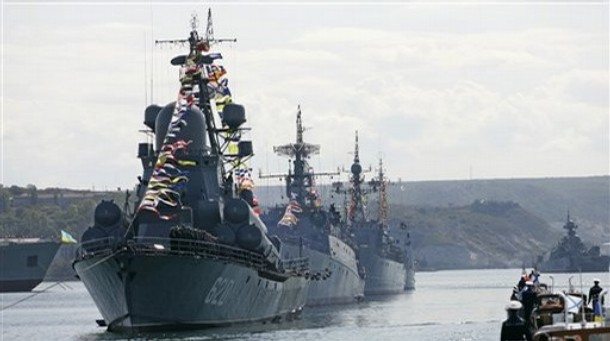Russia announced plans Tuesday to bolster its navy with more advanced weapons in response to NATO’s vow to halt the Kremlin’s push into Ukraine and feared expansion into eastern Europe.
Defence Minister Sergei Shoigu told a general security meeting that he expected to hear a detailed report from Russia’s navy commander about how this could be achieved efficiently over the coming six years.
“These proposals must ensure that our forces are reequipped with modern weapons and military equipment,” Russian news agencies quoted Shoigu as saying.
The new strategy “must also improve the operational readiness of Russian naval forces in locations posing the greatest strategic threat,” said Shoigu.
“I will not hide that this in large part is linked to events of recent months,” he said in reference to the pro-Russian insurgency convulsing eastern Ukraine.
NATO and the United States have both stepped up air defences of former Soviet satellites that are growing increasingly wary of Russia’s military ambitions and see President Vladimir Putin as a fast-emerging threat.
US President Barack Obama unveiled a $1 billion security plan for eastern Europe during a June visit to Poland that is aimed at helping countries on Russia’s western periphery build more modern armies.
And outgoing NATO chief Anders Fogh Rasmussen expressed concern last week that Putin’s ambitions went “beyond Ukraine” and now covered a Russian-speaking region of ex-Soviet Moldova and two separatist parts of the small Caucasus nation of Georgia — both now closely allied with the European Union.
Russian news reports did not immediately outline what proposal Shoigu and the navy command had in mind.
The Defence Academy of the United Kingdom — the official post-graduate school for the British military’s higher command — said Russia’s current plan through 2020 that Shoigu wants to update is focused on the development of nuclear-powered submarines and aircraft carriers.
France has irritated the United States by pushing through plans to deliver two Mistral-class helicopter carriers that Russia wants to station in Ukraine’s seized Crimea peninsula and near a string of disputed islands claimed by Japan.
‘Major problems with readiness’
Russia has only one functioning aircraft carrier that was first commissioned in the Soviet era and has been lacking the money and know-how to develop a more modern class.
The 10 active carriers available to the United States have posed one of the biggest obstacles to Putin’s hopes of countering Washington’s global domination with a new alliance between the Kremlin and nations such as China.
Putin promised ahead of his 2012 third-term election to nearly double Russia’s military spending over the coming decade to 23 trillion rubles ($635 billion, 475 billion euros).
But Russia’s current economic downturn has seriously threatened those plans.
The defence ministry’s attempts in the past two years to procure new weapons from its huge network of defence production facilities were hampered by the discovery that plants simply lacked the technology to churn out modern weapons in any significant quantity.
The Defence Academy of the United Kingdom notes that Russia’s “industrial base… remains a significant area of concern”.
“The Russian navy continues to have major problems with readiness and the quality of both personnel and equipment.”
Shoigu said that Russia’s recent attempts to improve procurement by awarding contracts to outside companies had also failed to live up to expectations.
“Outsourcing did not become the universal method of ensuring the Russian army’s needs,” Shoigu told the security meeting.
“We therefore must reform the existing system of providing for the armed forces.”










